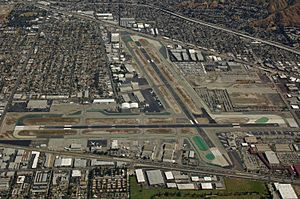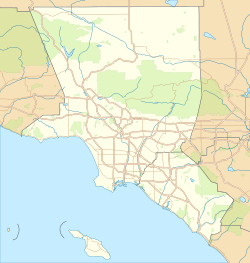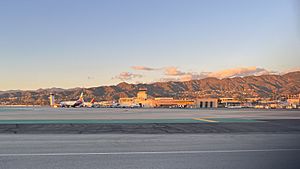Hollywood Burbank Airport facts for kids
Quick facts for kids
Hollywood Burbank Airport
Bob Hope Airport
|
|||||||||||||||
|---|---|---|---|---|---|---|---|---|---|---|---|---|---|---|---|

KBUR looking north, May 2018
|
|||||||||||||||
| Summary | |||||||||||||||
| Airport type | Public | ||||||||||||||
| Owner/Operator | Burbank–Glendale–Pasadena Airport Authority | ||||||||||||||
| Serves | Northern Greater Los Angeles area | ||||||||||||||
| Location | Burbank, California, United States | ||||||||||||||
| Focus city for | Avelo Airlines
JSX Ameriflight |
||||||||||||||
| Elevation AMSL | 778 ft / 237 m | ||||||||||||||
| Coordinates | 34°12′02″N 118°21′31″W / 34.20056°N 118.35861°W | ||||||||||||||
| Maps | |||||||||||||||
FAA airport diagram as of January 2021 |
|||||||||||||||
| Runway | |||||||||||||||
|
|||||||||||||||
| Statistics (2021) | |||||||||||||||
|
|||||||||||||||
|
Source: Hollywood Burbank Airport
|
|||||||||||||||
Hollywood Burbank Airport, also known as Bob Hope Airport, is a public airport in Burbank, California. It is about 3 miles (5 km) northwest of downtown Burbank. The airport serves the northern Greater Los Angeles area, including Glendale, Pasadena, and the San Fernando Valley.
This airport is closer to many popular places like Griffith Park, Universal Studios Hollywood, and Hollywood than Los Angeles International Airport (LAX). It is also the only airport in the area with a direct train connection to Downtown Los Angeles. You can reach it from two train stations: Burbank Airport–North and Burbank Airport–South.
The airport is owned by the Burbank–Glendale–Pasadena Airport Authority. This group is controlled by the governments of Burbank, Glendale, and Pasadena. The airport uses portable steps or ramps for boarding planes, instead of jet bridges. To help with noise abatement (reducing noise), most commercial flights are scheduled between 7:00 am and 10:00 pm.
Contents
Airport History and Names
The airport has had many names over the years. It started as United Airport in 1930. Then it became Union Air Terminal (1934–1940). After that, it was called Lockheed Air Terminal (1940–1967). Later, it was known as Hollywood–Burbank Airport (1967–1978). From 1978 to 2003, it was the Burbank–Glendale–Pasadena Airport.
In 2003, it was named Bob Hope Airport after the famous entertainer Bob Hope. He lived nearby and kept his personal plane at the airport. In 2017, the airport was rebranded as Hollywood Burbank Airport. This was done because many people did not know where "Bob Hope Airport" was located.
Building the Airport
United Aircraft and Transport Corporation (UA&T) built the airport. This company owned Boeing and United Airlines. They needed a new airport for their West Coast flights. They chose a 234-acre (0.95 km²) site in Burbank.
The land had many trees and vines, so it needed a lot of work. It was filled and leveled, but it had good drainage and steady winds. The construction was finished in just seven months. The runways were made of oil and sand, and they were very large for that time.
Early Days and Growth
United Airport officially opened on Memorial Day weekend in 1930. It had a beautiful Spanish Revival-style terminal. It was the biggest commercial airport in the Los Angeles area until 1946. That's when Los Angeles International Airport (LAX) started its scheduled flights.
In 1940, Lockheed bought the airport and renamed it Lockheed Air Terminal. During World War II, Lockheed's factories at the airport built many military planes. Airlines continued to fly from the airport even during this busy time.
In the late 1960s, jet planes started flying from Burbank. Airlines like Pacific Air Lines and Pacific Southwest Airlines (PSA) used jets for flights to cities like Las Vegas and San Francisco. In 1986, United Airlines even flew a large Boeing 767 jet from Burbank to Chicago. This was the biggest passenger plane ever to serve the airport.
Noise Rules and New Developments
In 1973, the Supreme Court of the United States made a decision about airport noise. The city of Burbank wanted to stop flights between 11:00 pm and 7:00 am. But the Supreme Court said that airports are controlled by the federal government.
Today, the airport has a voluntary system to reduce noise. Commercial flights are scheduled between 7:00 am and 10:00 pm. Also, most planes take off to the south on Runway 15 and land on Runway 8.
In 1978, Lockheed sold the airport to the Burbank–Glendale–Pasadena Airport Authority. The airport then got its fifth name: Burbank–Glendale–Pasadena Airport. In 2003, it was renamed Bob Hope Airport.
In 2014, a new $112 million Regional Transportation Center opened. This large building can handle a major earthquake. It also has solar panels to create electricity. A new parking garage was built too, with space for over 1,000 cars.
Noise Issues from Flight Path Changes
After the Federal Aviation Administration (FAA) changed flight paths in 2016, noise complaints at Hollywood Burbank Airport grew a lot. For example, in 2016, there were 577 complaints. By 2018, this number jumped to over 222,000. In the first half of 2019, it reached over 616,000.
The airport and local groups have tried to work with the FAA to fix this. They made 16 recommendations in 2020. However, the FAA said most of these ideas were not possible to do.
Future Plans for the Airport
There are plans to build a new terminal building at the airport. This new terminal would cost about $400 million. It would be built to meet modern earthquake safety rules. It would also be farther from the runway, as required by the FAA.
Voters in Burbank approved this plan in 2016. The new terminal will be about 355,000 square feet (32,981 square meters). It will have the same number of gates (14). Travelers will have more restrooms, more places to eat, and better security areas.
Airport Facilities
Hollywood Burbank Airport covers 555 acres (224 hectares). It is 778 feet (237 m) above sea level. The airport has two asphalt runways. Runway 15/33 is 6,886 feet (2,099 m) long. Runway 8/26 is 5,802 feet (1,768 m) long.
Planes usually take off on Runway 15 because of the wind. They usually land on Runway 8 because it has an ILS (a system that helps planes land in bad weather).
The airport also has its own fire department. This department helps with airport emergencies. They also check fire extinguishers and provide training. The fire department uses special fire trucks called Rosenbauer Panther 1500 vehicles.
Terminals
Hollywood Burbank Airport has two terminals, called "A" and "B". They are connected and are part of the same building. Terminal A has nine gates (A1 to A9). Terminal B has five gates (B1 to B5).
Getting to the Airport
You can reach Hollywood Burbank Airport by car using Interstate 5, California State Route 134, or California State Route 170. There are different parking options, including valet, short-term, and larger parking lots with shuttle buses.
Ride-sharing services like Lyft and Uber also serve the airport. You can be dropped off in front of the main terminal. For pickups, you go to the Short Term Parking structure across from the terminal.
There are also bus stops near the airport. Two train lines, Amtrak's Coast Starlight and Pacific Surfliner, and Metrolink's Ventura County Line, stop at the Burbank Airport–South station. This station is a short walk from the terminal. The Antelope Valley Line stops at the Burbank Airport–North station, which is about 1 mile north. A free shuttle takes passengers from there to the terminal.
Airlines and Destinations
Passenger Flights
| Airlines | Destinations | Refs |
|---|---|---|
| Advanced Air | Seasonal: Mammoth Lakes | |
| Alaska Airlines | Boise, Portland (OR), Santa Rosa, Seattle/Tacoma | |
| American Airlines | Dallas/Fort Worth, Phoenix–Sky Harbor | |
| American Eagle | Phoenix–Sky Harbor | |
| Avelo Airlines | Boise, Eugene, Eureka, Medford, Redding, Redmond/Bend, Santa Rosa, Tri-Cities (WA) | |
| Delta Connection | Salt Lake City | |
| Flair Airlines | Vancouver Seasonal: Edmonton |
|
| Frontier Airlines | Las Vegas Seasonal: Denver, Phoenix–Sky Harbor |
|
| JetBlue | New York–JFK | |
| JSX | Concord (CA), Denver–Rocky Mountain (begins August 4, 2022), Las Vegas, Monterey, Oakland, Phoenix–Sky Harbor, Reno/Tahoe | |
| Southwest Airlines | Albuquerque, Austin, Chicago–Midway, Dallas–Love, Denver, Houston–Hobby, Las Vegas, Nashville, Oakland, Phoenix–Sky Harbor, Reno/Tahoe, Sacramento, Salt Lake City, San Francisco, San Jose (CA) | |
| Spirit Airlines | Las Vegas | |
| United Airlines | Denver, San Francisco | |
| United Express | San Francisco |
Cargo Flights
| Airlines | Destinations |
|---|---|
| AirNet Express | Columbus–Rickenbacker |
| Ameriflight | Bakersfield, Oakland, Ontario, Santa Barbara, San Luis Obispo, Santa Maria Seasonal: Oxnard |
| FedEx Express | Fort Worth, Indianapolis, Memphis |
| UPS Airlines | Chicago/Rockford, Des Moines, Louisville |
Airport Statistics
Most Popular Destinations
| Rank | City | Passengers | Airlines |
|---|---|---|---|
| 1 | Las Vegas, Nevada | 311,000 | JSX, Southwest, Spirit |
| 2 | Phoenix–Sky Harbor, Arizona | 303,000 | American, JSX, Southwest |
| 3 | Oakland, California | 204,000 | JSX, Southwest |
| 4 | Sacramento, California | 176,000 | Southwest |
| 5 | Denver, Colorado | 167,000 | Southwest, United, Frontier |
| 6 | San Jose, California | 157,000 | Southwest |
| 7 | Seattle/Tacoma, Washington | 148,000 | Alaska |
| 8 | Salt Lake City, Utah | 116,000 | Delta, Southwest |
| 9 | San Francisco, California | 114,000 | Southwest, United |
| 10 | Dallas/Fort Worth, Texas | 97,000 | American |
| Rank | Airline | Passengers | Percent of market share |
|---|---|---|---|
| 1 | Southwest Airlines | 872,234 | 67.72% |
| 2 | American Airlines | 158,806 | 12.33% |
| 3 | Alaska Airlines | 129,383 | 10.04% |
| 4 | Delta Air Lines | 52,430 | 4.07% |
| 5 | United Airlines | 44,665 | 3.47% |
Yearly Passenger Traffic
| Year | Passengers | Year | Passengers | Year | Passengers |
|---|---|---|---|---|---|
| 2000 | 4,748,742 | 2010 | 4,461,271 | 2020 | 1,995,348 |
| 2001 | 4,487,335 | 2011 | 4,301,568 | 2021 | 3,732,971 |
| 2002 | 4,620,683 | 2012 | 4,056,416 | ||
| 2003 | 4,729,936 | 2013 | 3,844,092 | ||
| 2004 | 4,916,800 | 2014 | 3,861,179 | ||
| 2005 | 5,512,619 | 2015 | 3,943,629 | ||
| 2006 | 5,689,291 | 2016 | 4,142,943 | ||
| 2007 | 5,921,336 | 2017 | 4,739,466 | ||
| 2008 | 5,331,404 | 2018 | 5,263,972 | ||
| 2009 | 4,588,433 | 2019 | 5,983,737 |
Airport Incidents
- On September 21, 1938, a military plane crashed into a house in Burbank. The pilot, Major General Oscar Westover, and his mechanic were killed.
- On August 6, 1945, a P-80A plane crashed during takeoff. The pilot, Richard Bong, who was a famous fighter ace, died.
- On October 31, 1951, a Pacific Southwest DC-3 plane crashed shortly after takeoff. It landed in a cemetery south of the airport. The plane was damaged, but there were only minor injuries.
- On September 8, 1955, a Douglas DC-3 plane crashed on airport property. It was returning after an engine problem. The pilot, co-pilot, and an airport employee died.
- On December 14, 1962, a Flying Tiger Line Super Constellation cargo plane crashed. It happened in thick fog while trying to land. Seven people died, including the five people on the plane and two on the ground.
- On March 5, 2000, Southwest Airlines Flight 1455 overran the runway while landing. The plane crashed through a barrier and fence, stopping in the street. 44 people were injured. The pilots were later dismissed.
- On September 21, 2005, JetBlue Flight 292 had a problem with its nose landing gear. The plane flew for several hours before safely landing at LAX. News helicopters showed the event live on TV.
- On October 13, 2006, a Gulfstream Aerospace jet overran the runway. There were no injuries to the five passengers and two crew members.
- On December 6, 2018, Southwest Airlines Flight 278 overran the runway in heavy rain. The plane was stopped by a special safety system called EMAS.
See also
 In Spanish: Aeropuerto de Hollywood Burbank para niños
In Spanish: Aeropuerto de Hollywood Burbank para niños








